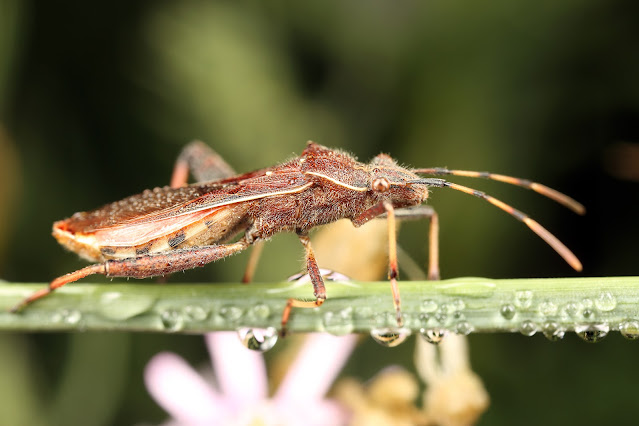Species diversity observed in 24 hours of macro photography
A few years ago I happened to schedule three separate macro photography sessions over the span of a bit under 24 hours. Each shooting session had a group of macro photographers shooting together.
When going to take photos of insects in an open area (e.g. not a jungle), we'd usually pick sunrise/sunset/night times, to avoid the harsh sunlight and the hyper activeness of the subjects.
Here are the photos I took, shot in Israel in early March.
1) Night session –
A bit before midnight in Caesarea
22:30 - arrive at the location, get my equipment ready and start looking around.
23:05 – The first cool photo I took was of a juvenile unidentified jumping spider (family Salticidae), this is a three-image focus stack.
This little jumper was
very inquisitive and curious, I did gently direct it to this position, which is
the reason you see sand particles on it.
23:18 – First time seeing this genus (Hypsicorypha) of plant-mimicking mantis from the family Empusidae, very delicate looking, even when compared to the more common plant-mimicking mantis in Israel (see further down below).
00:13 – A carpenter ant (Camponotus sp.) that was missing one of its mandibles, I wonder how can she survive like that.
1:09 – A flower chafer (most
likely Oxythyrea noemi) sleeping on a flower, completely drenched in dew.
2:00 - Drove to an IKEA parking lot to get some shut-eye and prepare for my next session. After a short talk with the security guards patrolling the parking lot, I was eventually approved to sleep in my car 😅
2) Morning session - Just before sunrise around Udim.
5:30 – woke up with a sore back, (1/10, would not recommend sleeping in a car) drove to Udim.
6:27 –
Male wasp mimicking long hoverfly (Sphaerophoria scripta), but what I
like most in this photo, is how the flower bud looks like a painting made with
pastels.
6:40 – Dew covered dragonfly.
I didn’t take a zoomed-out photo of it, so I’m actually not sure which Genus/species
it belongs to, let this be a lesson to me, I guess?
7:01 – Found a true
model, called in Hebrew “the daemon's horse”, this is an adult male from the
more common plant-mimicking
mantis species, Empusa
fasciata. I think they’re the most beautiful mantis species in Israel, see
for yourself.
7:33 – Mandatory dew-covered spider’s web.
7:47 – A shield
bug (Dolycoris baccarum), they are usually shot from the back,
but I really enjoy seeing the underside of true bugs and how their proboscis is
placed next to the bases of the legs.
7:53 - Broad-headed bug (I believe it’s Camptopus lateralis, but not 100% sure), a real nice looking true bug.
8:02 – Another
beautiful specimen – the Clouded Yellow butterfly (Colias croceus).
As mentioned at the beginning of this post, one of the advantages of taking photos a bit after sunrise is that it's too cold
for some of the insects to move. Focus stacking for live butterflies is possible
only during the night/sunrise. This is a 17-photo stack.
8:30 –
Drove back home and finally got some proper sleep!
3) Evening session – Just before sunset in Tel Hadid.
17:02 – A juvenile
leafhopper with a missing tarsus.
17:19 – Burnet
moth (Zygaena graslini) resting on a flower with aphids underneath it.
They are truly beautiful, but what I like the most about these moths are their Antennas!
18:47 – A bush cricket (Saga
sp.) nymph, this one is still small, but the adults of this genus are some
of the biggest katydids in the world.
19:02 – A bristletail (Family
Machilidae) that looks similar to the rock it’s on, both in color and texture. Fossil records of insects from this order were
dated back to 400 million years ago.
19:59 – A mantis hat-trick!
This pointy-eyed mantis (not an official name, species is likely Ameles
heldreichi) was cleaning its leg.
20:37 – What seems like a northern yellow
sac spider (Cheiracanthium Sp.) in a defensive position. I left it alone
after taking this photo.
20:44 – Harvestman from
the Family Phalangiidae. If you’ll look closely, you’ll be able to see the
mites that are catching a ride on it.
21:30 – going back home
after a full long day taking photos.
While I shot around 40 different
species during these 24 hours, in the photos above you can "only" see 19, belonging to 18 different families and 12 different orders.
Want to find cool bugs and don't know where to start? First a small word of warning - while the vast majority of insects and arachnids are harmless to humans, it's important to never touch or get too close to species you can't identify in order to confirm they indeed cannot do you any harm.
To find bugs, all you need to do is to go to the nearest field/park/garden you feel safe going to, find a random bush/plant and closely observe it (at least at the beginning, go during the day). even the smallest parks and gardens located inside the busiest cities are full of insects, spiders, and other critters.




















